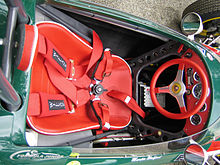Five-point harness


A five-point harness is a form of
Structure
The five-point harness is preferred as a safety
Helmet
There have been different models of helmets designed to hold the drivers head in place. A helmet restraint is equipped in some five-point harness seats to prevent brain and neck injury. For example, in NASCAR, it protects the driver in case of a car crash or an immediate change of velocity where the driver has limited control of his momentum.[4] The apparatus consists of a strap that runs from both of the sides of the helmet to the vehicle; or a strap connected to the vehicle from both sides of the driver that runs across the front of the helmet, instead of two independent straps on each side attached to the helmet. The mechanism is called a HANS (head and neck support) device[4]
Helmet straps
To prevent the helmet straps from impairing the drivers vision, there is a design where the straps are held
Child seats
The five-point harness is also used to buckle up children in
To assist caregivers in the safe transportation of children, the USA National Child Passenger Safety Board maintains the quality and integrity of the National Child Passenger Safety Certification Training Program.[7] The program is used to train and certify child passenger safety technicians and instructors. Three of the most common issues that put children at risk: improperly used or installed safety seats, children left in hot cars, and teen drivers.[8]
References
- ^ Bonsor, Kevin (2001-02-23). "How NASCAR Safety Works". Auto.howstuffworks.com. Retrieved 2013-10-13.
- ^ Speck, Shane (2003-07-04). "How Child Car Seats Work". Auto.howstuffworks.com. Retrieved 2013-10-13.
- ^ PMID 10367804.
- ^ a b c d e US patent 6381758B1, Lyman J. Roberts, II; Asif A. Lala & Panasarn Aim Jirut, "Head Restraint System for Racecar Drivers", published 7 May 2002
- ^ a b US patent 2002043831A1, Andrew Jackson Aslup, "Driver Head Restraint", published 18 April 2002
- PMID 17926766.
- ^ "National Child Passenger Safety Board". March 3, 2013.
- ^ "National Safety Council".
